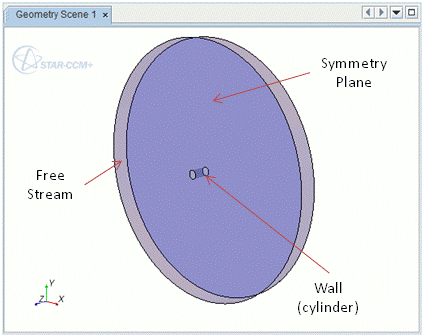Broadband Models: Noise from a Cylinder (Preparation)
This tutorial demonstrates how to set up aeroacoustics problems in Simcenter STAR-CCM+. The flow around a cylinder is used in the simulation to describe the required steps.
The simulation in this tutorial is an example of an application where the flow past a bluff body causes the shedding of unsteady vortices. The Reynolds number in this tutorial, 6.38E4, is in the subcritical range 300 < Re < 1.5E5. This indicates that the vortex shedding will be strong and periodic, exhibiting the familiar Karman vortex street. The onset of this phenomenon is inherently unpredictable.

The geometry consists of a cylinder, 20 mm in diameter, placed at the center of a three-dimensional circular computational domain, 0.6 m in diameter. The free-stream air velocity and temperature are set to be 50 m/s and 300K, respectively, corresponding to a Mach number of 0.144 (50.0/347.2) and a Reynolds number of 6.38E4 (1.184*50*0.02/1.85563E-5).
According to the recommended procedure, you first run in steady state to:
- Use the broadband models to understand where the aeroacoustics sources are located and to indicate where the mesh needs refining.
- Use the Mesh Frequency Cutoff estimator to prescribe the absolute cell size in the source region to satisfy frequency resolution requirements in transient flow.
Then, you activate an LES-based turbulence model in transient mode to capture the aeroacoustics sources directly and to:
- Use the post-processing tools to perform spectral analysis.
- Export the CFD fields for far-field noise propagation (suitable for non-compact sources).